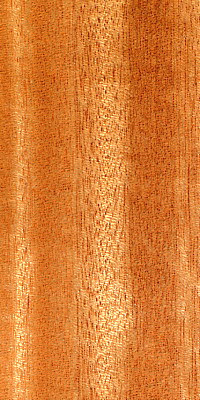

Okoume is one of the main exotic timber species exploited in the Congo Basin. Offering a relatively uniform appearance and tones ranging from light red to red brown, Okoume timber is widely used in the manufacture of plywood, and also to make furniture, moulding and panelling.

Aucoumea klaineana Pierre
Family:
BURSERACEAE (angiosperme)
Commercial restrictions:
No commercial restriction
Okoume is a large tree that can grow to over 50 meters in height and reach a diameter of 2 meters. The bole is long and cylindrical, rarely very straight; when it reaches between 30 and 40 cm in diameter, aliform buttress roots begin to develop.
The bark of young Okoumé is smooth and grayish. With age, it becomes reddish brown, very often with white, yellow, brown or red spots due to the presence of lichens. The bark cracks and exfoliates into large, thick, vertically elongated scales. With a thickness of 1 meter, its edge is pink and exudes a resin traditionally used to make incense and as an antiseptic.
Supplier: Okoume suppliers
Okoumé timber is a very light to light exotic wood, very soft to soft, with a light red to red-brown appearance that darkens with age.
Sensitive to termites and not very durable against fungi, it offers good resistance to dry wood insects, against which it is not necessary to treat Okoumé timber.
With Ozigo, Okoumé is one of the two species mainly exploited in Gabon; they represent more than two-thirds of the national production. Indeed, the characteristics of Okoumé make it particularly adapted to the peeling necessary for the manufacture of plywood: straightness and dimensions of the logs, homogeneous quality and low density. Because of its uniform appearance, Okoumé veneers are used both as face and inner plies for the manufacture of plywood for indoor or outdoor use under cover (risk of humidification). Okoumé is also used for interior joinery, furniture, moulding and panelling.
The tropical species Okoume is one of the main inhabitants of the forests of Gabon; its natural range also extends to Equatorial Guinea, southern Cameroon and northwestern Congo, from sea level to 1,000 meters above sea level.
Within its distribution area, Okoume enjoys relatively high humidity throughout the year, with rainfall ranging from 1500 to 3000 mm. The dry season lasts 3 months, from June to August. The thermal range is low (from 6° to 9° C) and the average temperature over the year is 26° C.
Okoume is by nature a pioneer and heliophilic species, which means that it needs a lot of light to develop. This tropical tree grows on all types of soils but prefers deep and fertile soils.
The exotix species Okoume is characteristic of several forest formations where it is associated with other species. Two types can be distinguished: the forest with Okoume and Ozouga (Sacoglottis gabonensis), linked to sandy, flat soils with a close water table, and the forest with Okoume, Ozigo (Dacryodes büttneri) and Aleppo (Desbordesia glaucescens), which covers the entire coastal hinterland.
The foliage of Okoumé is diffuse, green/grey, and persists all year long. New leaves grow between October and January and remain bright red for a few weeks, making the Okoumé clearly visible from the sky.
The flowering starts in August and lasts until November, with a shift from one geographical area to another.
Okoumé has a particularity concerning its root system: the roots can anastomose between different trees, i.e. the roots of several trees can merge, thus ensuring the survival for several years of stumps that have been exploited.
See Tropix sheet of Okoumé (CIRAD).
See Tropix sheet of Okoumé (CIRAD).
See Tropix sheet of Okoumé (CIRAD).
See Tropix sheet of Okoumé (CIRAD).
Sources : CIRAD - ATIBT
Copyright photo: Q. Meunier, C. Moumbogou, J.-L. Doucet, 2015 (bole)
use(s) for this species :